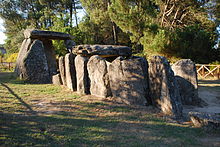Great Dolmen of Zambujeiro is a megalithic monument located in Nossa Senhora da Tourega, near Valverde, in the municipality of Évora, considered one of the biggest such structures in the Iberian Peninsula.

Mangualde is a municipality in the subregion of Dão-Lafões, central region of Portugal. The population in 2011 was 19,880, in an area of 219.26 km2.

The Prehistoric Rock-Art Site of Escoural Cave is a structure known for its Paleolithic-era rock-art and funerary burial site, located in the Portuguese municipality of Montemor-o-Novo, in the civil parish of Santiago do Escoural.

The National Museum of Archaeology is the largest archaeological museum in Portugal and one of the most important museums devoted to ancient art found in the Iberian Peninsula. Located in Lisbon, the museum was founded in 1893 by the archaeologist José Leite de Vasconcelos. The museum is located in the western wing of the Jeronimos Monastery where the monks had their dormitory. The museum is built in the Neo-Manueline style and was officially opened in 1906.

The Fountain of the Idol is a Roman fountain located in the civil parish of São José de São Lázaro, in the municipality of Braga, northern Portugal. Located in the former territory of the Callaici Bracari, the granite rock fountain/spring has Latin inscriptions, dedicated to the Gallaecian and Lusitanian gods Tongoenabiagus and Nabia.
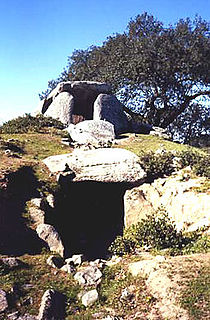
The Great Dolmen of Comenda da Igreja is a megalithic funerary site in the civil parish of Nossa Senhora do Bispo, in the municipality of Montemor-o-Novo, in the central Alentejo region of continental Portugal.
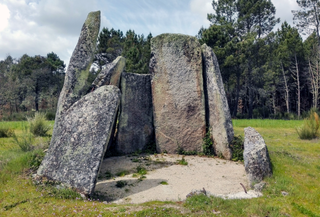
Dolmen of Carapito I is a megalithic monument located in the civil parish of Carapito, in the municipality of Aguiar da Beira in the Guarda District of Portugal.
The Prehistoric Rock-Art Site Pala Pinta is a Paleolithic-era rock-art site, recognized for cave paintings in the Portuguese municipality of Alijó, in the civil parish of Carlão e Amieiro.

The Castle of Ródão is a medieval castle located in the civil parish of Vila Velha de Ródão, in the municipality of Vila Velha de Ródão, Portuguese Castelo Branco.

Anta is the Portuguese name for about 5,000 megaliths built during the Neolithic period in the area of Portugal. The Anta das Pedras Grandes is a late-Neolithic site located in Casal Nova in the parish of Caneças, in the Odivelas municipality, in the Lisbon District of Portugal. It was classified as a National Monument in 1944. Excavations in the early 21st century suggest that it was originally built as a dolmen or single-chamber megalithic tomb, consisting of a polygonal long chamber with eight supporting stones about 3 metres tall, and a short access corridor. There are traces of a tumulus, and human bones have been discovered. Excavations in the surrounding area also identified many flint chippings, suggesting that the area was used for the production of flint items.

The Anta do Monte Abraão was a megalithic dolmen located in the parish of Monte Abraão, in Queluz, Sintra Municipality, Lisbon District, Portugal. The dolmen was first identified in 1876, by Carlos Ribeiro, who carried out excavations until 1878 and published his results in 1880. Excavations suggest that it served as a tomb for about 80 individuals and that it dates back to the middle to end of the Neolithic period. The Anta do Monte Abraão and the nearby Anta da Pedra dos Mouros and Anta da Estria are collectively known as the Antas de Belas.
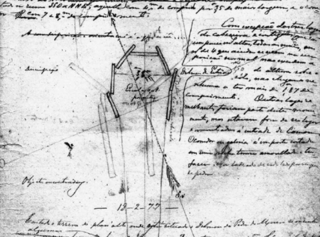
The Anta da Estria is a megalithic dolmen situated between Belas and Queluz in the Lisbon District of Portugal. Based on datings of human remains, it is believed to date back to the late-Neolithic and early-Chalcolithic eras. The Anta da Estria, the Anta do Monte Abraão and the Anta da Pedra dos Mouros are collectively known as the Antas de Belas, and were first identified in the 1870s by Carlos Ribeiro (1813-1882), who is regarded as the "father" of Portuguese prehistoric archaeology.

The Anta de Agualva, also known as the Anta do Carrascal, is a megalithic dolmen situated in an urban area of Agualva-Cacém in the municipality of Sintra, in the Lisbon District of Portugal. First identified by Carlos Ribeiro in 1875, the dolmen has recently been restored and can be easily visited.

The Anta de Carcavelos, located close to the village of Carcavelos near the town of Lousa in the municipality of Loures in the Lisbon District of Portugal, is a stone age dolmen or megalithic monument from the Chalcolithic period. It is one of many such tombs that have been identified in Portugal.

The Anta do Alto da Toupeira, also called the Anta da Toupeira or the Anta de Salemas, is a Neolithic dolmen, or megalithic tomb, situated in the parish of Lousa in the municipality of Loures, in the Lisbon District of Portugal. It dates back to the Chalcolithic.

The Necropolis of Carenque is an archaeological site consisting of three well-preserved late Neolithic collective sepulchres or tombs, dating back to about 3000 BCE, which are dug into smooth limestone outcrops. It is situated in the municipality of Amadora in the Lisbon District of Portugal.
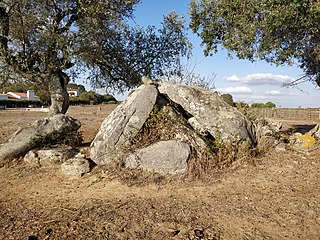
The Antas da Valeira are two Chalcolithic dolmen, or burial chambers, about 100 metres apart, close to the village of Nossa Senhora da Graça do Divor in the Évora district of the Alentejo region of Portugal. Situated in a farm field about one kilometer from the Vale Maria do Meio Cromlech and ten kilometers from the notable megalithic complex of the Almendres Cromlech, these dolmen are among numerous megalithic sites identified in the Évora area. These two monuments have yet to be studied by archaeologists and are in a poor condition.

The Antas do Olival da Pêga are located near the village of Telheiro, in the municipality of Reguengos de Monsaraz, in the Évora district of the Alentejo region of Portugal. Anta is the Portuguese name for a dolmen, a single-chamber megalithic tomb. These two neolithic dolmens were used over a long period, from the late neolithic to the chalcolithic. The tombs were originally identified by the German archaeologists, Georg and Vera Leisner, who excavated Anta 1, with Anta 2 being subsequently excavated from the 1990s by Victor Gonçalves and Ana Catarina Sousa of the Centre of Archaeology of the University of Lisbon (UNIARQ). In addition to the visible stones at the two sites, which are about 300 meters apart, many items have been found as a result of excavations. Over one hundred people were buried in each tomb. The proximity of the two tombs gives rise to the conclusion that both were part of the same megalithic complex.

Irisalva Moita was a Portuguese archaeologist and museum conservator and curator.
